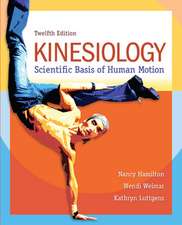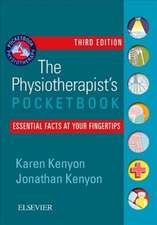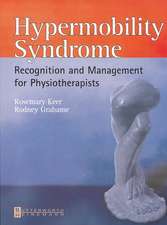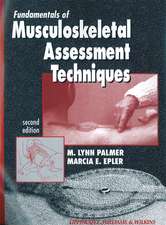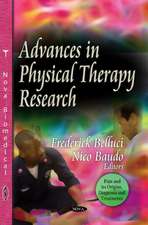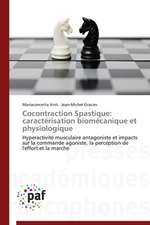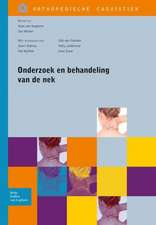Guided Self-Rehabilitation Contract in Spastic Paresis
Autor Jean-Michel Graciesen Limba Engleză Paperback – oct 2022
Preț: 357.77 lei
Preț vechi: 376.59 lei
-5% Nou
Puncte Express: 537
Preț estimativ în valută:
68.47€ • 74.35$ • 57.51£
68.47€ • 74.35$ • 57.51£
Carte tipărită la comandă
Livrare economică 22 aprilie-06 mai
Preluare comenzi: 021 569.72.76
Specificații
ISBN-13: 9783319291079
ISBN-10: 3319291076
Pagini: 118
Ilustrații: XIX, 118 p. 65 illus.
Dimensiuni: 127 x 203 mm
Greutate: 0.15 kg
Ediția:1st ed. 2022
Editura: Springer International Publishing
Colecția Springer
Locul publicării:Cham, Switzerland
ISBN-10: 3319291076
Pagini: 118
Ilustrații: XIX, 118 p. 65 illus.
Dimensiuni: 127 x 203 mm
Greutate: 0.15 kg
Ediția:1st ed. 2022
Editura: Springer International Publishing
Colecția Springer
Locul publicării:Cham, Switzerland
Cuprins
Part I: Lower limb anatomical review 1.- Hip.- Gluteus maximus.- Hamstrings.- Hip flexor.- Hip extensor.- Hip adductors.- Hip internal rotators.- Knee.- Rectus femoris.- Vastus muscles.- Ankle.- Soleus.- Gastrocnemius.- Lower limb functional exercises.- Part II: Upper limb anatomical review.- Shoulder.- Pectoralis major.- Latissimus dorsi.- Long head of triceps.- Sub-scapularis.- Elbow.- Elbow flexors.- Pronator quadratus.- Pronator teres.- Wrist.- Wrist flexors.- Hand.- Flexors of digits.- Interosseus muscles.- Thumb.- Long thumb flexor.- Short thumb flexor.- Opponens pollicis.- Long abductor of the thumb.- Active thumb deopposition/opposition.- Adductor pollicis.- Appendix.- Personal log sheet lower limb.- Personal log sheet upper limb.- Neuroloco.
Notă biografică
Jean-Michel Gracies, MD, PhD, is Clerkship Director of the Neurology Department and Assistant Professor of Neurology at Mount Sinai Medical Center, in New York, New York.
Dr. Gracies completed his residency in intensive care, neurologic rehabilitation, neurology, and stroke pathology at Hôpitaux de Paris, France, and received his medical degree and doctorate in neurophysiology from the University of Paris VI, earning the highest possible grade for both theses. He completed a postdoctoral fellowship in pathophysiology and therapy of spasticity at Prince of Wales Medical Research Institute, in Sydney, Australia, and a fellowship in neurology and movement disorders at Mount Sinai Medical Center.
Some of his research focuses on perfecting diagnostic methods for Parkinson’s disease and generating algorithms for the adjustments in deep brain stimulation. He is principal investigator for research projects aimed at ameliorating motor function in spastic paresis, tremors, and Parkinson’s disease. These projects concentrate on improving evaluation methods for muscle overactivity, injection techniques and action mechanisms of botulinum neurotoxin in spastic paresis and tremors, and other focal treatments for spastic paresis.
Dr. Gracies lectures internationally on the pathophysiology and treatment of spasticity, the treatment of tremors using botulinum neurotoxin, and programming methods for deep brain stimulation and has authored more than 90 original articles, book chapters, theses, reviews, and abstracts.
Dr. Gracies has served on the editorial board of Journal of Neural Transmission. Currently, he is an ad-hoc reviewer for many journals, including Archives of Physical Medicine and Rehabilitation, Movement Disorders, Muscle Nerve, Stroke, Experimental Brain Research, American Journal of Rehabilitation, Brain, Journal of Applied Physiology, Lancet Neurology, and Journal of Neurology, Neurosurgery, and Psychiatry. Dr. Gracies is a member of the Neurotoxin Institute and the International Movement Disorders Society.
Some of his research focuses on perfecting diagnostic methods for Parkinson’s disease and generating algorithms for the adjustments in deep brain stimulation. He is principal investigator for research projects aimed at ameliorating motor function in spastic paresis, tremors, and Parkinson’s disease. These projects concentrate on improving evaluation methods for muscle overactivity, injection techniques and action mechanisms of botulinum neurotoxin in spastic paresis and tremors, and other focal treatments for spastic paresis.
Dr. Gracies lectures internationally on the pathophysiology and treatment of spasticity, the treatment of tremors using botulinum neurotoxin, and programming methods for deep brain stimulation and has authored more than 90 original articles, book chapters, theses, reviews, and abstracts.
Dr. Gracies has served on the editorial board of Journal of Neural Transmission. Currently, he is an ad-hoc reviewer for many journals, including Archives of Physical Medicine and Rehabilitation, Movement Disorders, Muscle Nerve, Stroke, Experimental Brain Research, American Journal of Rehabilitation, Brain, Journal of Applied Physiology, Lancet Neurology, and Journal of Neurology, Neurosurgery, and Psychiatry. Dr. Gracies is a member of the Neurotoxin Institute and the International Movement Disorders Society.
Textul de pe ultima copertă
This book is an informative guide for both the patient and therapist, and provides a series of exercises that target the most important muscles for those with spastic paresis. Actively practicing the exercises prescribed in this self-rehabilitation manual will allow the patient to see continued improvement in their muscle functioning. Spastic paresis is the consequence of a central nervous system disorder such as a stroke, traumatic brain or spinal cord injury, multiple sclerosis, or a tumor of the nervous system, conditions that may have occurred in childhood or adulthood. In spastic paresis two problems coexist: the word 'paresis' means that when the brain sends a command to a muscle to contract, this order is incompletely received by the muscle; the word 'spastic' indicates that at the same time muscles cannot relax normally and have a tendency to be spontaneously overactive. A daily program of prolonged stretching and an intensive motor training program using unassisted large amplitude rapid alternating movements is recommended to gradually increase brain command effectiveness.
Caracteristici
Represents a practical and informative guide for both the patient and the therapist Provides a series of exercises targeting the most important muscles for people with spastic paresis Includes a personal log for patients to record their passive stretches and active training

